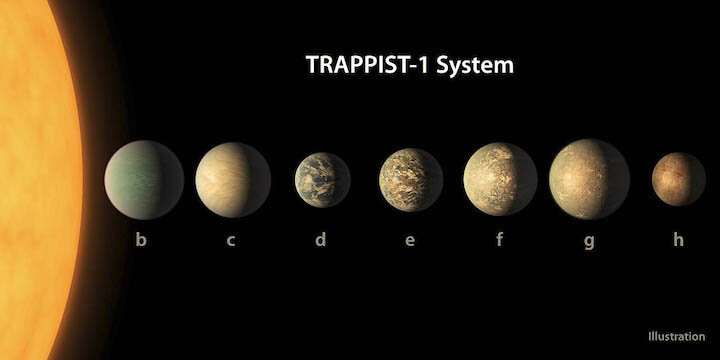Energetic particles can bombard exoplanets

TRAPPIST-1 is a system of seven Earth-sized worlds orbiting an ultra-cool dwarf star about 120 light-years away. The star, and hence its system of planets, is thought to be between five-to-ten billion years old, up to twice as old as our own solar system. For scientists seeking evidence for life elsewhere, the advanced age provides more time for chemistry and evolution to operate than the Earth had. On the other hand, the planets are all close to the star (in fact they are probably tidally locked to the star with one side always facing it), and consequently would have soaked up billions more year's-worth of high energy radiation from the star's winds, adversely affecting any atmospheres they host.
In a new paper in the Astrophysical Journal, CfA astronomers Federico Fraschetti, Jeremy Drake, Julian Alvardo-Gomez, Sofia Moschou, and Cecilia Garraffo and a colleague carry out theoretical simulations of the effects of high-energy protons from a stellar wind on nearby exoplanets. These particles are produced by stellar flares or by shock waves driven by magnetic events in the stellar corona. Measurements of solar eruptive events provide the scientists with a basis for their simulations.
The astronomers calculate the first realistic simulation of the propagation of energetic particles through the turbulent magnetic field environment of an M dwarf star and its wind, and they tailored the details to the TRAPPIST-1 system. They find that particles are trapped within the star's magnetic field and are directed into two polar streams focused onto the planets' orbital plane - independent of many of the details. The scientists conclude that the innermost putative habitable planet in the system, TRAPPIST-1e, is bombarded by a proton flux up to a million times larger than that experienced by the present-day Earth. Nevertheless, there are many variables at play, for example the angle between the magnetic field and the rotation axis of the star, and consequently a large uncertainty remains in how these effects actually are manifest in individual situations.
More information: Stellar energetic particles in the magnetically turbulent habitable zones of TRAPPIST-1-like planetary systems. arxiv.org/abs/1902.03732
Journal information: Astrophysical Journal
Provided by Harvard-Smithsonian Center for Astrophysics




















